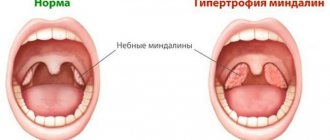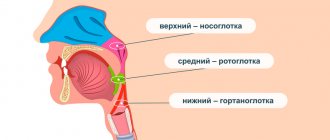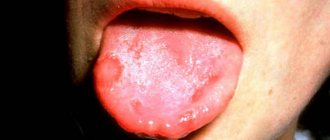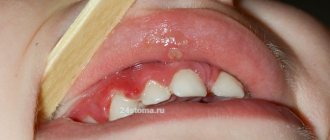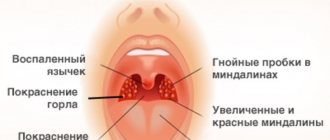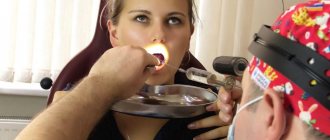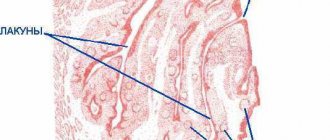For every parent, there is nothing worse than a child’s illness. I would like to help in any way possible. One of the common pathologies is chronic tonsillitis - inflammation of the pharyngeal tonsils. The main reason for its occurrence is weakened immunity.
It is less common in children under 3 years of age; children from 3 to 12 years of age are most susceptible. If you suspect such a disease in your child, it is worth making an appointment with a pediatric ENT specialist, as untimely treatment can lead to unpleasant complications.
Causes of redness in the throat
In most cases, redness of the mucous membrane of the throat is combined with pain when swallowing and occurs as a result of the development of tonsillopharyngitis1. Isolated damage to the pharynx (pharyngitis) and pharyngeal tonsils (tonsillitis) is rare, and there is nothing surprising about this: the pharynx and tonsils are located close to each other1,2,4.
Most often, inflammation of the pharynx is accompanied by acute respiratory infections (ARI). In preschool children, in 89% of cases, ARI is caused by viruses 1. The mucous membrane of the pharynx and tonsils is a favorite place for rhinoviruses and adenoviruses, as well as parainfluenza viruses. Less commonly, its inflammation is caused by the Epstein-Barr virus, enterovirus (Coxsackie virus), and herpes simplex virus1,2,5.
The viral nature of tonsillopharyngitis predominates in children aged 1 to 5 years3. Starting from the age of five, children more often suffer from bacterial forms of the disease. Moreover, in 20-30%1,2,4,5,7 (according to some data, in 75%3) of young patients, doctors find a dangerous bacterium in the throat and tonsils - beta-hemolytic streptococcus of group A2,3,4,5,6 .
Other microbes can also cause redness in the throat: mycoplasma, chlamydia, staphylococcus and Candida fungi2,3. Sometimes tonsillopharyngitis becomes one of the manifestations of a general disease2,3: diphtheria, scarlet fever, infectious mononucleosis, tularemia, typhoid fever or even HIV3. Treatment will be different in each case.
Diagnostic methods
The diagnosis and treatment of tonsillitis in a child is carried out by a pediatrician or otolaryngologist. This disease must be distinguished from other infectious pathologies, including diphtheria and catarrhal tonsillitis. Therefore, you should also contact a pediatric allergist-immunologist and infectious disease specialist. After the examination, the doctor will prescribe laboratory tests (smear for microflora and sensitivity to viruses, bacteria, general blood test. Source: https://www.ncbi.nlm.nih.gov/pmc/articles/PMC5807738/ Thea Brennan-Krohn, Al Ozonoff and Thomas J. Sandora Adherence to guidelines for testing and treatment of children with pharyngitis: a retrospective study // BMC Pediatr. 2018; 18: 43
For recurrent forms of the disease, endoscopy of the nose and nasopharynx, consultation with an allergist, examination by a gastroenterologist, and endoscopy of the larynx will be required. All this is necessary to identify the true nature of the pathology.
Symptoms to watch out for
The development of tonsillopharyngitis in a child is difficult to miss. Children are extremely sensitive to sore throats1,5,6. With its appearance, babies' sleep and appetite are disrupted, they become capricious and whiny1,6. Older children complain of a sore throat and sore throat when swallowing6,7. They develop a dry, superficial cough1,7.
A runny nose, red throat and fever in a child, especially in the autumn-winter period and early spring, most often indicate a cold, that is, ARVI1. The mucous membrane of the pharynx looks reddened, swollen, loose, dry or moist, covered with cloudy mucus1,2.
With an adenovirus infection, these symptoms include redness of the white membrane of the eyes, swelling of the eyelids, lacrimation, and “films” typical of adenoviral conjunctivitis appear in the eyes. 1.2. Lymph nodes enlarge. Sometimes nausea, vomiting and abdominal pain occur1. Upon examination, the pharyngeal mucosa appears slightly reddened, loose, with whitish deposits and lumps of thick mucus1,2.
The development of tonsillopharyngitis may be associated with enterovirus infection caused by Coxsackie viruses1,2. Enteroviral vesicular pharyngitis is called herpetic sore throat, since the rash resembles the blisters of herpes 2. Blisters filled with cloudy liquid appear on the reddened mucous membrane of the pharynx and oral cavity, and even on the plantar surface of the feet and palms. Possible muscle and abdominal pain1.
Fever, red throat and cough in a child may be manifestations of infectious mononucleosis associated with Epstein-Barr viruses1,2. In this case, in addition to redness and swelling of the mucous membrane of the pharynx, purulent “films” on the tonsils, all lymph nodes, liver and spleen are also enlarged1,2.
Tonsillopharyngitis caused by beta-hemolytic streptococcus is considered the most dangerous form of the disease2,3. This is due to the large number of complications that infection2 can lead to if it is not treated or treated incorrectly.
Streptococcal tonsillopharyngitis sometimes leads to the development of peritonsillar abscess, rheumatic fever, glomerulonephritis, and bacterial endocarditis2.
The following symptoms will help you suspect that redness in the throat is the result of the activity of streptococci:
- high temperature (> 380 C);
- absence of runny nose and cough;
- severe sore throat, forcing you to refuse food;
- severe swelling of the tonsils;
- the appearance of pinpoint hemorrhages (petechial rash) on the mucous membrane of the tonsils, soft palate and pharyngeal walls;
- purulent plaque on the tonsils, tightly connected to the underlying tissues;
- the appearance of ulcers and erosions on the tonsils in places where plaque is rejected;
- enlarged cervical lymph nodes2,3,7.
If a child has a red throat, but no temperature, this is a reason to think about non-infectious causes. Redness of the pharyngeal mucosa in a baby can be caused by prolonged crying, staying in a smoky room, eating too cold or hot food, or trauma to the pharynx with sharp objects. Sometimes the mucous membrane is colored red by dyes found in foods. The doctor takes all this into account when diagnosing tonsillopharyngitis1,2.3.
How to cure tonsillitis
If a loose throat is a consequence of a chronic inflammatory process, this is not a death sentence at all. Modern medicine has new methods for treating tonsillitis, and some of them have proven to be very effective.
- Vacuuming is the suction of purulent contents from the lacunae of the tonsils. After the procedure, the throat is treated with an antiseptic solution with an antibiotic.
- Washing the tonsils. The procedure is carried out with a 100 ml syringe, with which the otolaryngologist treats loose tonsils with an antiseptic solution.
- Ultraviolet, laser therapy and ultrasound are local disinfecting effects on the tonsils.
The above physiotherapeutic procedures are a chance to cure and preserve tonsils. If left untreated, tonsillitis can become a direct indication for their removal. Vacuuming has proven to be the most effective. The duration of treatment is 1.5-2 months.
Surgery is a last resort. Today, doctors advocate preserving the tonsils, even if the child has a loose throat and suffers from sore throats. However, if tonsillitis takes an acute form 3-4 times a year, the tonsils have to be cut out.
Obviously, loose tonsils in a child are not a reason to panic, but parents should make every effort to prevent this condition from developing into chronic tonsillitis. Sanitation of the oral cavity and larynx, rinsing and taking appropriate medications to strengthen the baby’s local immunity will help cope with this problem. If you take all preventive measures and follow the recommendations of the otolaryngologist, your throat will be healthy.
What to do if a child has a red throat?
A red throat as a symptom is very rarely isolated. It is accompanied by other signs that add up to one or another clinical picture. Only a doctor can correctly assess it and select adequate treatment. Therefore, if your child’s throat is red, you should definitely visit the children’s clinic.
Which doctor should I contact? Of course, to the pediatrician. If necessary, he will refer you to the right specialist, an infectious disease specialist or an ENT doctor.
Treatment of tonsillopharyngitis, which is prescribed by doctors, usually includes general and local therapy. If the disease is caused by bacterial microflora, antibiotics are used1,2,7. For viral infections there is no point in using them: viruses are not sensitive to these drugs2,4,5,7.
Antipyretic drugs based on paracetamol and ibuprofen2,4 approved for children are used as needed, mainly when the temperature rises above 380 C and/or poor heat tolerance1,3.
In local therapy, drugs based on antiseptics1,3,4 are widely used - substances with antimicrobial effects. Preference is given to those forms that are easy to use and have a pleasant taste, which is especially important for children1,5,6.
For local treatment of inflammatory diseases of the pharynx in children over 3 years of age, depending on age, HEXORAL®2,3,4,5,6 preparations can be used. Aerosols and lozenges are especially convenient6,7.
HEXORAL® aerosol with mint flavor is approved for use in the treatment of children over 3 years of age8. It is based on the antiseptic hexetidine, which has a wide spectrum of antimicrobial action, is active against some viruses, and can have a mild analgesic effect8. A convenient bottle with a nozzle allows you to spray the drug evenly over the entire surface of the pharynx.
If a child is over 3 years old and already knows how to gargle, HEXORAL®11 solution can be used for the rinsing procedure. In addition, the solution is suitable for treating the throat with a tampon.
HEXORAL® tablet forms are distinguished by a variety of tastes.
“Mint” HEXORAL® TABS based on the antiseptic chlorhexidine and the local anesthetic benzocaine can complement the traditional therapy of tonsillopharyngitis in children 4 years of age and older9.
HEXORAL® CLASSIC with the flavors of orange, lemon, black currant, lemon and honey with lemon is suitable for children over 6 years old10.
Adolescents over 12 years of age are allowed to use HEXORAL® EXTRA tablets, which, in addition to the antiseptic component, contain the anesthetic lidocaine, which can relieve even severe sore throat12.
If your child is sick, you should consult a pediatrician in any case. Only he is able to determine how to treat the baby, because a red throat can be a symptom of a serious disease.
The information in this article is for reference only and does not replace professional advice from a doctor. To make a diagnosis and prescribe treatment, consult a qualified specialist.
to come back to the beginning
Literature
- I. N. Zakharova, E. B. Machneva. Pediatrician tactics for acute tonsillopharyngitis in children. Medical Council No. 1, 2022 pp. 128-132.
- Zaitseva S.V., Zastrozhina A.K., Kulikova E.V. Acute tonsillitis in the practice of a pediatrician. Medical advice. 2019; 2: 113-119.
- G. A. Samsygina. Acute tonsillopharyngitis in children. Pediatrics2008/Vol. 87/No. 3 pp. 91-95.
- S.A. Karpishchenko, S.I. Alekseenko, S.V. Baranskaya. Treatment of tonsillopharyngitis in children // Medical Council, No. 1, 2022, pp. 70–75.
- Karpishchenko S.A., Lavrenova G.V., Alekseenko S.I., Muratova E.I. Issues of choosing drug therapy for sore throat in children. Pediatrics (Appendix to the journal Consilium Medicum). 2018; 1:39–42. DOI: 10.26442/2413-8460_2018.1.39-42.
- HELL. Vetrova. Acute tonsillitis in children: a pediatrician’s point of view // Pediatric pharmacology. 2014; 11 (2): 61–64.
- Piskunov V.S., Nikitin N.A. Symptomatic treatment of tonsillopharyngitis in acute respiratory viral infection in frequently ill children. Pediatrics. Consilium Medicum. 2019; 1:44–51. DOI: 10.26442/26586630.2019.1.190192.
- Instructions for use of the drug HEXORAL® aerosol: .
- Instructions for use of the drug HEXORAL®TABS: .
- Instructions for use of the drug HEXORAL®CLASSIC: .
- Instructions for use of the drug HEXORAL® SOLUTION: .
- Instructions for use of the drug HEXORAL® TABS EXTRA: .
Provoking factors
The nasopharynx is the first to encounter infections from the outside. This is why the throat gets sick more often than other organs. Loose tonsils may indicate a viral infection in the body. It is ARVI that most often causes throat diseases in children. Less commonly, the disease is bacterial or fungal in nature. Additional symptoms help determine the true cause of the disorder.
The situation can be aggravated by:
- weakened immunity and frequent colds;
- hypothermia or overheating;
- insufficient oral hygiene;
- chronic diseases of the ENT organs;
- thermal or mechanical damage to the mucosa.
Pain and sore throat are the first symptoms of scarlet fever. Enlargement and soreness of the tonsils may indicate the penetration of a coccal infection. In the presence of a chronic focus of inflammation, enlargement and hyperemia of the throat mucosa often occur, which means that the process has reached a critical point.
